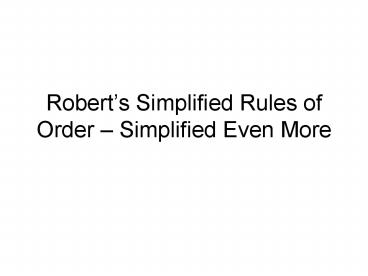Roberts Simplified Rules of Order Simplified Even More - PowerPoint PPT Presentation
1 / 8
Title:
Roberts Simplified Rules of Order Simplified Even More
Description:
... a seconder...the mover usually begins debate with a supporting statement ... If an amendment is proposed, the speaking list shifts to debate on the amendment. ... – PowerPoint PPT presentation
Number of Views:342
Avg rating:3.0/5.0
Title: Roberts Simplified Rules of Order Simplified Even More
1
Roberts Simplified Rules of Order Simplified
Even More
2
The Agenda
- Determines the business of the meeting
- Created by the Chairperson, agenda items
submitted by meeting participants - May have standing items like committee
reports - Usually has a new business section for items
added as the meeting begins - Is adopted at the beginning of the meeting
(potentially after amendments) - Can be amended mid meeting with 2/3 vote to deal
with emergent motions
3
Main Motions
- A proposal to do something or adopt a policy
- Should be
- About one thing
- Describe clear action
- State who is to do what
- Be within the terms of reference of the group
- Have a mover and a seconderthe mover usually
begins debate with a supporting statement
4
Amendments
- If the meeting wants to alter the motion as a
result of the debate that occurs, it is usually
helpful to make an amendment to the motion. - Amendments should
- Not change the intent of the main motion
- Add or insert words strike words or both
- Be precise
- Can have an amendment to an amendment, and so
forth
5
Speaking to Motions Voting
- Once a motion is on the floor, speaking should be
to the motion to keep the debate focused - If an amendment is proposed, the speaking list
shifts to debate on the amendment. - Once the amendment is voted on and accepted or
rejected, the speaking returns to the list for
the main motion (possibly in its amended form) - The last step is the vote on the main motion
- A motion is carried with 50 1 votes unless
there is some rule to say otherwise
6
Interrupting Things
- Sometimes it is OK to interrupt the debate
- You can interrupt the current speaker for
- Point of privilege (Can we shut the door)
- Point of order (Tell the chair they have made a
procedural error e.g. current speaker was not
next on the list)
7
Interrupting the Speakers List
- You can immediately speak next to
- Challenge the chair
- Point of information (clarify something)
- Call for a count on a vote
- Reconsider (to vote again on a motion that has
been carried this meeting requires 2/3 vote)
8
Procedural Motions
- These motions are intended on aiding the meeting
with dealing with a motion. You can - Suspend the rules
- Consider seriatim (consider a long motion by
parts rather than all at once) - Change methods of voting (e.g. ask for a secret
ballot) - Lay on the table (make a motion go into a
netherwordit disappears until someone takes it
from the table) - Call the question make the meeting vote on
whether to continue debate or vote right away
used to save time - Limit or extend debate
- Postpose to a definite time (e.g. next meeting)
- Refer (e.g. to another committee)































